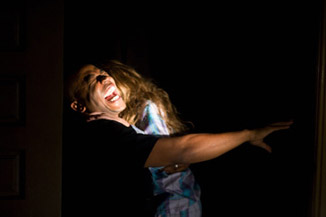Movie Review: Quarantine
By Matthew Huntley
October 22, 2008
BoxOfficeProphets.com

The set up is simple: A television reporter and her cameraman shadow a unit of the Los Angeles Fire Department for a behind-the-scenes story. The firemen receive a call to investigate a disturbance in an old apartment building. After they arrive, everyone inside is locked in by the Center for Disease Control. They're "quarantined" for unknown reasons, with no hope of being let out.
Why are the reporter, her cameraman, the firemen and all the apartment's tenants locked inside? That's for you to find out, and that's also part of the fun of Quarantine, which is more interested in craft and style than cheap thrills and gratuitous violence. Don't get me wrong, there are plenty of thrills and violence in it, but the movie doesn't show them unnecessarily. They're provoked by the characters' impending doom and their unthinkable situation.
Like Cloverfield from earlier this year, Quarantine is all told from a single camera perspective and meant to appear as "actual footage" of the events. Angela Vidal (Jennifer Carpenter) is the giddy reporter assigned to document the L.A. Fire Department. She gets a kick out of sliding down the pole, peaking in on the men in their dorm rooms, and betting her interviewees she can put on a uniform faster. Her cameraman is Scott, played by Steve Harris, whom I give credit for taking a role that's mostly heard and rarely seen. I doubt Harris actually operated the camera, but it sure seemed like he did.
The firemen are Jake (Jay Hernandez) and George (Johnathon Schaech), who, along with a local policeman (Columbus Short), answer a call about a sick and deranged woman making strange noises inside her apartment. When they confront her, she's unresponsive, immobile and has saliva and blood dripping from her throat. The rest of the building's tenants are a motley crew of characters from all races and ethnicities, but the movie avoids the cliche of making them colorful, witty and full of resources. They're mostly scared, angry and prone to panicking, as anyone would be. The movie strives to be realistic in this regard.
I'll avoid any more plot details, but needless to say, there are violent attacks (by what, I won't say), people start dying and the answers to our questions are limited. Director John Erick Dowdle, who co-wrote the screenplay with Drew Dowdle, knows the less knowledge he gives his characters about their ordeal, the less we know and therefore the tenser it becomes. Watching this movie will make you feel claustrophobic, helpless and frustrated, which is mostly the point. But there are also genuine shocks, which, for once, are not apparent so far in advance.
There will be a lot of critics who say Quarantine rips off Cloverfield because of its single camera technique, but that's not really fair. If a technique works for certain material, why shouldn't the filmmakers utilize it? For Quarantine, it's not just a gimmick and I believed, just as I did with Cloverfield, that real people would be inclined to tape everything in this kind of situation, especially this day and age when so much reality is documented with a camera.
In the end, Quarantine didn't scare me as much as it made me feel restless, and I remained curious about where it was going all the way to the end. During the final scene, hints are shown that could potentially explain the plot, but they're only hints, and it's that last point that will make it last longer in people's minds.